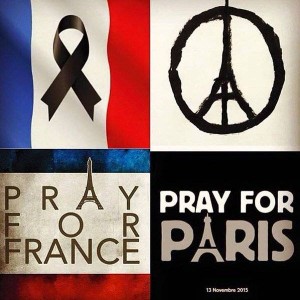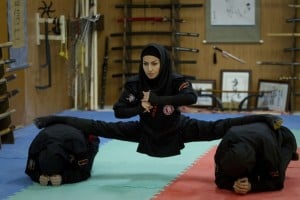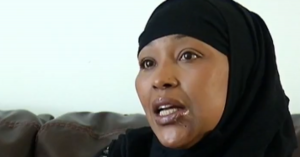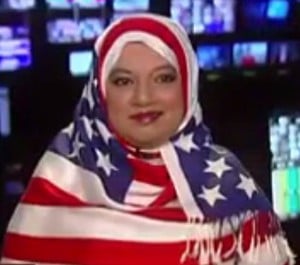As the debate on Quebec’s Charter of Secularism (formally the unaptly named Charter of Values) rages on, two Montreal professors wore the hijab to demonstrate their solidarity with Muslim women. In short, the Charter of Values in Quebec is a proposed law that bans the visibility of religious symbols – hijabs, kippa, crosses, turbans – in public spaces. Effectively, if the law passes, anyone employed by and paid through the public purse may be disallowed from wearing anything that could be construed as religious. (For a fuller discussion of the Charter and its implications, refer to Krista’s MMW post from September.)
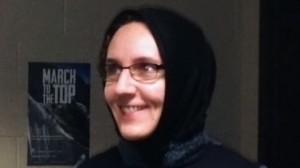
Nora Jaffary, a history professor at Concordia University, and Catherine Lu, a political science professor at McGill University, have worn the hijab to their classes in protest of the proposed charter. Jaffary, who as of November 25th was still wearing the hijab on campus grounds, points out that the vast majority of Muslim women have the autonomy to choose the hijab and that the charter instead singles out visible minorities. She goes onto say, “If many people are wearing religious signs, it’s impossible to tell who’s wearing them for what reason and so it sort of muddies the waters.”
Jaffary’s and Lu’s iintentions are incredible, especially in the context of a public debate that has been venomous and xenophobic. By being so public in their support for, in particular, the religious rights of Muslim women, Jaffary and Lu risk the ire of a Quebec populace among whom the Charter has substantial popularity. Yet, to be bluntly honest, this act of solidarity does not sit well with me.
I realize Jaffary’s and Lu’s intentions aren’t those of “costuming,” but other instances and events in which racial, cultural, and religious symbols or items have been appropriated are relevant to the discussion here. These stories often remind me, at least at first glance, of Black Like Me. The book is an account of John Howard Griffin’s travels across America’s south with his skin darkened to develop insight into the experiences of African Americans. Griffin received critical acclaim for his book which included raw, horrific, and violent accounts of his experiences, ultimately being credited for identifying racism in ways that were accessible, and perhaps palatable, to white people. His work, however, also minimizes the experiences of Black people in America. The experiences of African Americans encompass more than just their day-to-day interactions within a white normative world; they include complex experiences of racism, such as intergenerational violence, poverty, and institutionalized discrimination. Traveling in the south for 6 weeks, as Griffin did, cannot in any way capture that. Moreover, the book’s approach shifts focus away from African American experiences of racism and, instead, onto Griffin, a white man trying to understand racism.
In the context of Muslim women, issues related to “costuming” remind me of topics I’ve written about before, Donnarama’s Islamophobic drag performance on one hand, and Lady Gaga’s ridiculous pink burka on the other. Both Donnarama and Gaga used the burka to transform Muslim women into caricatures, simple cardboard cutouts seen only for the scarves that may veil our faces and cover our hair. More subtly, discussions about “costuming” are also analogous to debates about “hijab tourism” and the awesome upacking Shireen did with her post about World Hijab Day. In the links to both posts, MMW writers articulate their views on non-Muslim women who have worn the hijab in order to improve their understandings of Muslimah experiences. Nicole pointed out, for example, “I don’t understand why people think dressing up in a hijab, or in a burqa, can recreate the experience of a woman who wears hijab. Yes, in a day, or a month, in hijab, you might get the blank stares, the cutting remarks—but you don’t get the whole experience.” In her post, Shireen wrote, “This exercise reduces a Muslim woman to one yard of material. It is not an action that one can adequately educate and put another woman in their position. It’s completely disingenuous to think so.”
No, I do not think that Jaffary’s and Lu’s goals in donning scarves were to experience life as hijabi Muslimahs. And, as a contrary to the stereotypical characterizations of hijabi women, their demonstrations did not mock Muslim women. They did not themselves suggest that we need to be saved or that we’re not sophisticated enough to make decisions about our own clothing.
Their acts of wearing hijab, however, inadvertently play into the discourse created by the Charter of Secularism. Akin to the effects of “costuming,” the Charter simplifies complex religious identities into religious clothing and symbols. While Jaffary and Lu give the hijab visibility, the complex identities, histories, and experiences of Muslim women get lost in the process. For much of their interview on Daybreak Montreal for CBC Radio, Jaffary and Lu were constantly being cornered into explaining whether hijabs, niqabs, and burqas were oppressive. Yes, that’s in large part due to the the direction of the host and interviewer, Mike Finnerty. However, given that Jaffary and Lu are non-Muslims wearing the hijab, the knee jerk media curiosity is to explore this particular aspect of their experience. I realize that for a non-Muslim woman to wear the hijab is a media-savvy means of drawing attention to the xenophobic mess that is the proposed Charter. But that tactic also focuses media attention on Jaffary, Lu, and the hijab and away from Muslim women who struggle with the real Islamophobic implications of the Charter, including reports that suggest that an increasing number of Muslimahs are experiencing verbal harassment and physical violence.
The Charter of Secularism isn’t about the hijab, or the kippa and turban, for that matter. It isn’t about facilitating religious neutrality in a secular world. Instead, it establishes normative social boundaries, outside the limits of which behaviours are deemed unacceptable. In the context of this hateful venom that can make living in the West an awfully lonely place, the support is absolutely welcome. But we can be smarter about developing practices of protest that don’t perpetuate an oversimplification of Muslim women’s identities. That, for me, is meaningful solidarity.


